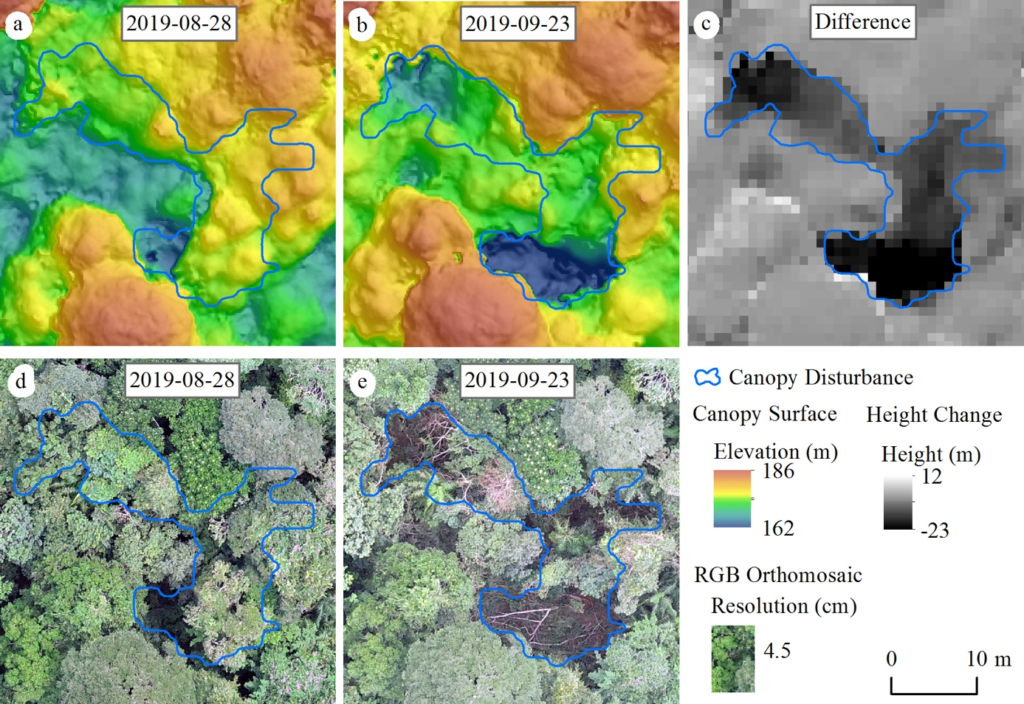Scientists revealed the temporal variation in canopy disturbances using a unique dataset of five-year monthly drone-acquired imagery

Figure. Canopy disturbance visualized on canopy surface models and orthomosaics calculated from photogrammetric analyses of drone imagery. (a,b) Elevation models for a portion of the study area on two successive dates, 28 August 2019 (a) and 23 September 2019 (b). (c) Difference in elevation between the two dates, with black area indicating large decrease in canopy elevation. (d,e) RGB orthomosaics of the same dates.
The Science
A mechanistic understanding of how tropical tree mortality responds to climate variation is urgently needed to predict how tropical forest carbon pools will respond to anthropogenic global change. Researchers used five years of approximately monthly drone-acquired imagery for 50 ha of tropical forest on Barro Colorado Island, Panama, to quantify temporal variation and climate correlates of treefalls, branchfalls, or collapse of standing dead trees. They found that canopy disturbance rates are highly temporally variable, and are well-predicted by extreme rainfall events. Treefalls accounted for 77 % of the total area and 60 % of the total number of canopy disturbances in treefalls and branchfalls combined.
The Impact
Moist tropical forests account for 40% of the global biomass carbon stocks, and uncertainty regarding the future of these stocks is a major contributor to uncertainty in the future global carbon cycle. An improved understanding of the processes of forest disturbance is critical to constrain estimates of current and future carbon cycling in tropical forests under climate change. Results demonstrate the utility of repeat drone-acquired data for quantifying forest canopy disturbance rates at fine temporal and spatial resolutions, thereby enabling robust tests of how temporal variation in disturbance relates to climate drivers.
Summary
The size distribution of canopy disturbances was best fit by a Weibull function, and was close to a power function for sizes above 25 m2. Canopy disturbance rates varied strongly over time and were higher in the wet season, even though windspeeds were lower in the wet season. The strongest correlate of temporal variation in canopy disturbance rates was the frequency of 1-hour rainfall events above the 99.4th percentile (here 35.7 mm hour-1, r = 0.67). Scientists hypothesize that extreme high rainfall is associated with both saturated soils, increasing risk of uprooting, and with gusts having high horizontal and vertical windspeeds that increase stresses on tree crowns.
Contacts (BER PM): Daniel Stover, SC-23.1, Daniel.Stover@science.doe.gov (301-903-0289)
Science Contact: Raquel Fernandes de Araujo, STRI, araujo.raquelf@gmail.com
Funding
Next Generation Ecosystem Experiments-Tropics, funded by the U.S. Department of Energy, Office of Science, Office of Biological and Environmental Research; Smithsonian Institution Competitive Grants Program for Science; Smithsonian Tropical Research Institute fellowship program.
Publications
Araujo, R. F., Grubinger, S., Celes, C. H. S., Negrón-Juárez, R. I., Garcia, M., Dandois, J. P., and Muller-Landau, H. C. (2021), Strong temporal variation in treefall and branchfall rates in a tropical forest is explained by rainfall: results from five years of monthly drone data for a 50-ha plot, Biogeosciences Discuss. [DOI: 10.5194/bg-2021-102]